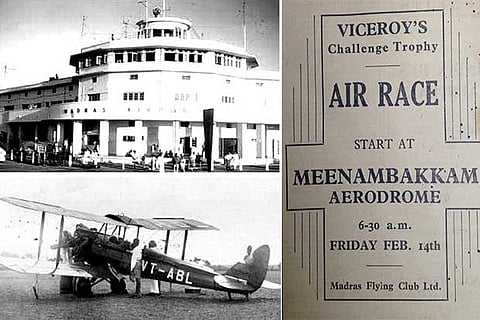

Chennai
Flying machines came to Madras just seven years after the Wright brothers. After millennia of myths around flying machines and men, the first man in Asia to actually fly did so on the island in the midst of the Cooum in 1910. But the week before that, Giacomo D’Angelis, a Corsican baker, had tested the flying contraption he had fabricated in the space between Adyar river and St Thomas Mount.
Though surrounded by hills, this place attracted future fliers as well. The major effort to put the Madras Presidency on the aviation map of India happened during the World War II, especially after the fall of Singapore. So desperate was the Royal Air Force (RAF) that they even landed seaplanes even on the water of Red Hills reservoir. Thirteen aerodromes were commissioned in south India and existing ones taken over by the RAF.
The existing flying strips were mainly those run by flying clubs, for aviation was the chosen hobby of the rich and famous in those years. In 1930, the Madras Flying Club (MFC) was founded with mostly Europeans as members. Some Indians (particularly Nagarathar businessmen) joined the club in Meenambakkam. The club was just a concrete strip for planes to land and a small tin shed for the members to relax. One of its members, JW Madeley, a water engineer of the Madras, used to fly off daily to inspect the lakes of fresh water which would have taken him days to circumnavigate and inspect on the road.
In 1932, JRD Tata launched India’s first airline, Tata Airlines, by piloting the first flight himself from Karachi to Mumbai via Ahmedabad on a single-engine Puss Moth aircraft with a freight of airmail. Neville Vincent, a former Royal Air Force pilot, flew the plane to Madras.
During World War II, what we now know as the Chennai airport was then called RAF St Thomas MT when it was used along with Sholavaram, Tambaram and Avadi to support the allied effort against the Japanese. Its main role was to facilitate recovery and to provide rest-in-transit to the Allied planes flying East. It was also used for training of fresh pilots.
The airport witnessed a frenzy of air and ground activity during the wars, the accounts about which is deprived by wartime censorship. After the war, it was officially called the aerodrome and civilian aircrafts began landing here.
Finally, post freedom, the Madras airport was sanctioned in 1948, being one of the first aerodromes in the country. The existing aerodrome was enlarged with modern installations. The Central PWD was asked to use surplus war materials to speed up the work. Madras airport was the headquarters of Alagappa Chettiar’s Jupiter Airways. But during the initial years, it had to lease all its planes to the Indian Union for the Kashmir war effort in initial years.
The airstrip was lengthened to become the Meenambakkam aerodrome, named after the village near it. An art deco structure painted in yellow, which had a waving gallery to receive and see off guests. It even allowed cinema shootings. The VIPs of the government and several Indian leaders were flying into Madras. The old Madras airport will soon be pulled down to pave the way for the straightening of a taxiway at the airport.
Surprisingly, the initial airport had a village in the middle where people had to be shooed off the runway when a landing was scheduled. With aircraft arrivals being infrequent, the runway was occasionally used for the races conducted by the Madras Motor Sports Club before it shifted to Sholavaram in 1955.
Initially, Viscounts and Dakotas were the most frequent planes. There was a daily night airmail service operating to other metros. A newspaper plane also used to take off early in the day to drop loads of newspapers all over the state. With more planes frequenting Madras, safety measures increased. The church spire of the nearby Garrison Church which has a famous address of No 1 GST Road was trimmed as it was on the flight path.
The Aero Club of India and Burma announced that the Viceroy’s Challenge Trophy Air Race to be flown on February 14, 1936, over the following course: Madras, Hyderabad, Bombay, Ahmedabad, Jodhpur and Delhi — a distance of 1,485 miles. It commenced in Meenambakkam and might have been a popular annual event but for the break of the World War.
Subsequently, when the airport needed more space, they expanded over to the next village of Trisulam and earlier airport was converted into the cargo section. The second runway was built on a bridge over Adyar river. The bridge actually narrows the river down and speeds it up during the monsoons and floods the city.
—The writer is a historian and author
Visit news.dtnext.in to explore our interactive epaper!
Download the DT Next app for more exciting features!
Click here for iOS
Click here for Android